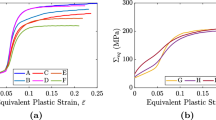Abstract
Shrinkage porosity and gas porosity occur simultaneously and at the same location when conditions are such that both may exist in a solidifying casting. Porosity formation in a solidifying alloy is described numerically, including the possible evolution of dissolved gases. The calculated amount and size of the porosity formed in Al-4.5 pct Cu plate castings compares favorably with measured values. The calculated distribution of porosity in sand cast Al-4.5 pct Cu plates of 1.5 cm thickness matches experimental measurements. The decrease of the hydrogen content by strong degassing and the increase of mold chilling power are recommended to produce sound aluminum alloy castings. The calculated results for steel plate castings are in agreement with the experimental work of Pellini. The present modeling has clarified the basis of empirical rules for soundness and suggests that the simultaneous occurrence of shrinkage and gas evolution is an essential mechanism in the formation of porosity defects.
Similar content being viewed by others
References
A. Jeyarajan and R.D. Pehlke:Trans. Amer. Foundrxmen’s Soc., 1978. vol. 86. pp. 457–64.
W. C. Erickson:AFS Int. Cast Metals J., 1980. vol. 5. no. 1, pp. 30–41.
E. Niyama, T. Uchida. M. Morikawa. and S. Saito:AFS Int. Cast Metals J., 1981. vol. 6. no. 2. pp. 16–22.
I. Imafuku:Trans. Japan Soc., of Mech. Engrs., Ser. C, 1981. vol. 47. pp. 918–26.
T. S. Piwonka and M.C. Flemings:Trans. TMS-AIME, 1966, vol. 236. pp. 1157–65.
J. Campbell:AFS Cast Metals Res. J., 1969. vol. 5. no. 1, pp. 1–8.
V. de L. Davies:AFS Cast Metals Res. J., 1975. vol. 11. no. 2, pp. 33–44.
I. Ohnaka. Y. Mori. Y. Nagasaka, and T. Fukusako:J. Japan Foundrymen’s Soc., 1981. vol. 53, pp. 673–79.
J.C. Fisher:J. App. Phys., 1948. vol. 19. pp. 1062–67.
K. Kubo, R. D. Pehlke, and T. Fukusako*: The University of Michigan, Ann Arbor, MI and *Osaka University, Suita, Osaka, Japan, unpublished research, 1984.
M.C. Flemings:Solidification Processing. McGraw-Hill Book Co., New York. NY. 1974. pp. 34. 148. 207. and 234.
H. Bester and K.W. Lange:Arch. Eisenhiittennes.. 1972. vol. 43. pp. 207–13.
J.B. Murphy:Acta Metall., 1961. vol. 9, pp. 563–69.
P.C. Carman:Trans. Inst. Chem. Eng., 1937. vol. 15. pp. 150–66.
E.T. Turkdogan:Trans. TMS-AIME. 1965. vol. 233. pp. 2100–12.
P. J. Roache:Computational Fluid Dynamics. Hermosa Publishers, 1972. p. 64.
M. Hansen:Constitution of Binary Alloys. 2nd ed. McGraw-Hill Book Co., New York. NY. 1958. pp. 84–90. 353-65.
S. Matoba. K. Gunji. and T. Kuwana:Tetsu to Hagané. 1959, vol. 45. pp. 229–232.
T. F. Bower. H.D. Brody. and M.C. Flemings:Trans. TMS-AIME. 1966. vol. 236. pp. 624–34.
T. Z. Kattamis. J.C. Coughlin, and M.C. Flemings:Trans. TMSAIME. 1967. vol. 239. pp. 1504–11.
A. Suzuki. T. Suzuki. Y. Nagaoka, and Y. Iwata:Tetsu to Hagané, 1968. vol. 32. pp. 1301–05.
K. Mori. A. Kamimori, M. Deguchi. and T. Shimoda:Tetsu to Hagané. 1973. vol. 59, pp. 887–97.
S. Nishi and T. Kurobuchi:Keikinzoku. 1974, vol. 24. pp. 245–54.
B.R. Deoras and V. Kondic:Foundry Trade J., 1956, vol. 100, pp. 361–64.
S. Nishi, Y. Shinada. and T. Kurobuchi:Keikinzoku. 1974. vol. 24. pp. 130–34.
K. Kubo. T. Fukusako, and I. Ohnaka:J. Japan Foundrymen’s Soc., 1979. vol. 51. pp. 586–91.
W. S. Pellini:Trans. Amer. Foundrymen’s Soc., 1953, vol. 61, pp. 61–80.
P. R. Beely:Foundry Technology. Butterworths, London, 1972, p. 112.
C.E. Ransley and D.E. Talbot:Z. Metallknde., 1955, vol.46, p. 328.
Author information
Authors and Affiliations
Rights and permissions
About this article
Cite this article
Kubo, K., Pehlke, R.D. Mathematical modeling of porosity formation in solidification. Metall Trans B 16, 359–366 (1985). https://doi.org/10.1007/BF02679728
Received:
Issue Date:
DOI: https://doi.org/10.1007/BF02679728




